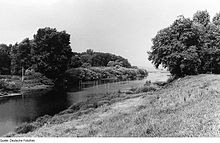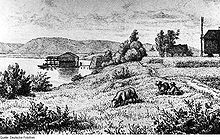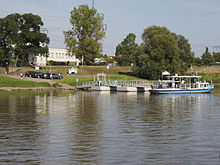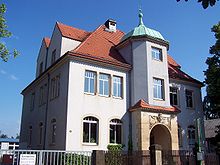Kötitz
|
Kötitz
Large district town of Coswig
Coordinates: 51 ° 7 ′ 0 ″ N , 13 ° 34 ′ 20 ″ E
|
|
|---|---|
| Height : | 108 m above sea level NN |
| Incorporation : | April 1, 1935 |
| Postal code : | 01640 |
| Area code : | 03523 |

Kötitz is a place and a district in Coswig in the Saxon district of Meißen .
geography
Kötitz is located in the extreme south of the Coswig urban area. The Coswig town center borders in the north, and the Brockwitz district in the northwest . Kötitz is located on the banks of the Elbe , just above the Gauernitz Elbe island , in the north-western part of the Elbe valley . On the opposite bank is Gauernitz , a village in the municipality of Klipphausen . To the east is the Radebeul district of Naundorf .
Around the center of the corridor, the village center was preserved in the form of a street perch village . The industrial areas Naundorfer Straße and Grenzstraße are located in the south and north-east of Kötitz. The western part of the corridor is largely undeveloped, there is also the Kötitzer gravel pit , a flooded open pit that was used as a bathing lake .
history

The village was first mentioned in a document in 1203 as "villa Chottenwiz" as part of a donation by Dietrich the distressed to the Altzella monastery . Over the centuries the place name changed, among other things, via the forms "Kothenewicz" (1350 in Friedrichs des Strengen's loan book ), "Koterwicz", "Köthewitz", "Caititz" and "Kädewitz" to the current name. It goes back to Old Sorbian and is derived either from "Chotên", a locator name , or from "kotici", German cat.
Finds of 300 graves from a Bronze Age burial ground of the Lusatian culture prove the early presence of humans in the area. The construction of the village took place at a ford . On the 216 hectare (as of 1900) large Kötitzer Gewannflur there were not only a forest called “Kötitzer Tännicht” but also fields, vineyards and the floodplain of the Elbe and its tributaries and oxbow lakes. Accordingly, in addition to agriculture and cattle breeding, the residents also cultivated wine and fishing. The village had its own Elbe harbor and two mills. In the electoral ship mill, first mentioned in 1601, the farmers of the surrounding villages had to grind their grain. There has also been a ferry connection to the other bank of the Elbe to Gauernitz since the 17th century . The village was parish into neighboring Coswig.
Throughout history, the village of Kötitz has been plagued by disasters. The village fire of 1806 had a devastating effect, in which almost the entire village was destroyed. When it was rebuilt after the great fire, Kötitz received its current structure. The Elbe flood in 1845 also caused severe damage , which turned Kötitz into an island and flooded parts of the village. Another serious fire in 1866 destroyed nine farms.
Just one kilometer north of the village center, there was an early stop on the first German long-distance railway line Leipzig – Dresden , which opened in 1839 and , together with steam navigation on the Elbe, promoted the industrialization of Kötitz. At the end of the 19th century there was a settlement of industrial companies and a sudden increase in population. The Tännicht straw material factory had been producing since 1884, and the E. Nacke machine factory in Kötitz from 1891 . As a result of industrialization, forests and vineyards were completely displaced.
In 1901 the municipality of Kötitz founded its own volunteer fire brigade , a year earlier a new school building had already been built. The local council, which has existed since 1839, moved into the newly built town hall in 1907. Kötitz also had its own prison, and the port, which has been used up to the present day, was also important for industry. In a vote, 90 percent of the residents of Kötitz in 1920 decided against incorporation into Coswig. Nevertheless, it was carried out 15 years later under the National Socialists . Since then, Kötitz, which has no district status, has shared the history of Coswig.
Population development
|
Personalities
- Teresa Carreño (* 1853 in Caracas ; † 1917 in New York ), Venezuelan pianist and composer, lived in Kötitz from 1891 to 1895
- Eugen d'Albert (* 1864 in Glasgow ; † 1932 in Riga ), German pianist and composer, lived in Kötitz from 1891 to 1895
- Emil Nacke (* 1843 in Großwiederitzsch ; † 1933 in Kötzschenbroda ), German mechanical engineer, first Saxon automobile manufacturer
- Carl Schröder (* 1904 in Kötitz, † 1997 in Radebeul), German puppeteer and director
literature
- Kötitz . In: August Schumann : Complete State, Post and Newspaper Lexicon of Saxony. 5th volume. Schumann, Zwickau 1818, p. 30.
- Cornelius Gurlitt : Kötitz. In: Descriptive representation of the older architectural and art monuments of the Kingdom of Saxony. 41. Issue: Administrative Authority Meißen-Land . CC Meinhold, Dresden 1923, p. 248.
Web links
- Kötitz in the Digital Historical Directory of Saxony
- History of Kötitz on www.coswig.de
- History of Kötitz on www.historisches-coswig.de
- Local association Kötitz
- History of the Kötitzer ferry
Individual evidence
- ^ Michael Rademacher: German administrative history from the unification of the empire in 1871 to the reunification in 1990. City and district of Meißen. (Online material for the dissertation, Osnabrück 2006).




